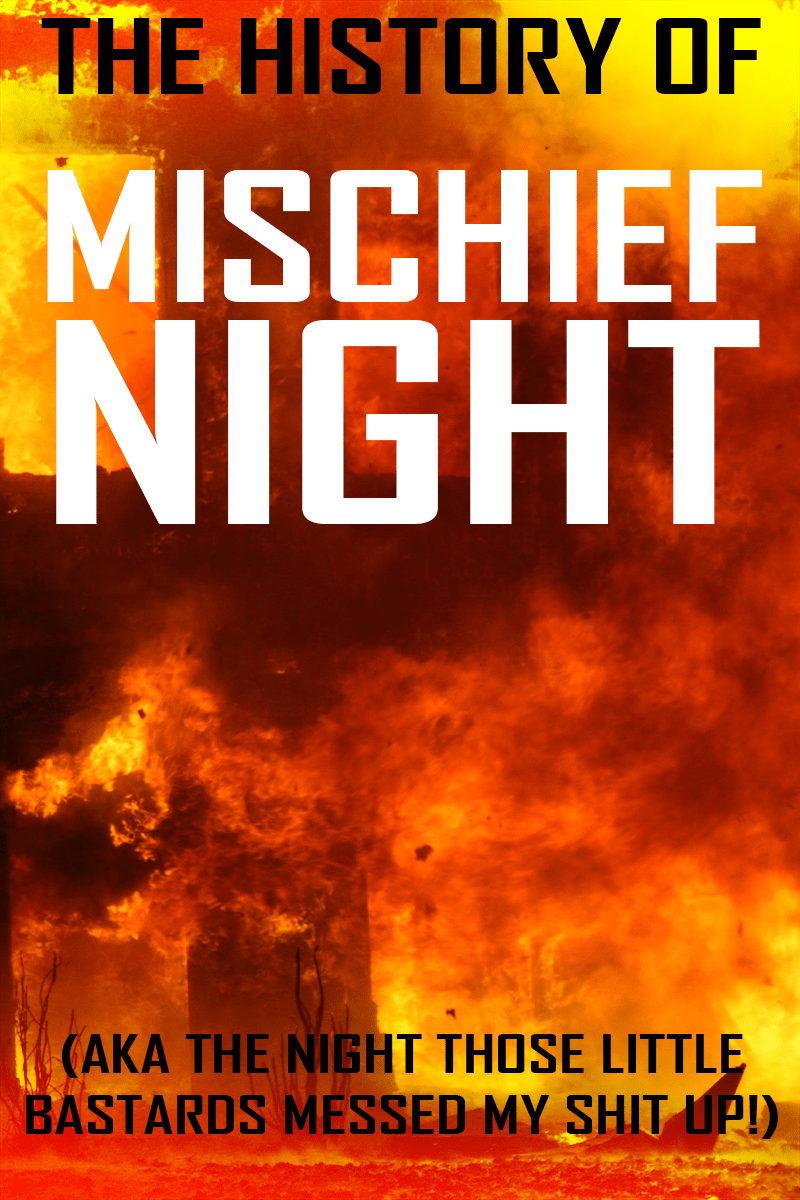
The History of Mischief Night
(AKA The Night Those Little Bastards Messed My Shit Up!)
Ahhh Mischief Night, that time of year when the air is filled with the promise of pranks, laughter, and a touch of chaos. It’s a holiday that transcends generations, captivating the hearts of children, teenagers, and some freaky adults. Not sure what Mischief Night is? Well, let’s explore its origin and evolution.
The Origins of Mischief Night
Over in certain regions of England, the playful antics of Mischief Night didn’t always coincide with Halloween. Instead, they had their roots in the May Day celebrations. However, someone decided it was time to shake things up a bit and move the mischief to a different time of year. Various regions opted for different dates. Some held fast to the classic allure of November 4th, the night before Bonfire Night (AKA Guy Fawkes Night), while others chose to dive into the fun on October 30th, the eve of Halloween. Nowadays, the latter has become the preferred occasion for the revelry.
Mischief in America
Mischief Night as we know it today began to take shape in the United States during the early 20th century. Communities across the country saw an influx of pranks, often involving harmless mischief like toilet papering houses, soaping windows, and egging cars. It was all in good fun, a rite of passage for youngsters to engage in playful tricks, and a time for teenagers to show their rebelliousness.
These pranks typically came with a set of unwritten rules – no permanent damage, no harm to people or animals, and, most importantly, no crossing the line into vandalism or criminal activities. It was a night filled with laughter and a bit of suspense as people wondered what surprises Mischief Night would bring.
Mischief Night soon became an outlet for creativity, as participants dreamed up elaborate pranks that would surprise and amuse their neighbors.
One famous Mischief Night tradition is the “doorbell ditch.” Another tradition is the creation of “dummy” figures, often dressed in old clothes and left sitting on porches or driveways, confusing anyone who stumbles upon them.
The Most Mischiefy of Mischief Nights
During the Great Depression, Detroit was grappling with unemployment and economic hardships. It was in this environment that the tradition of Devil’s Night began. In the 1930s, it was still known as “Mischief Night” or “Hell Night.” As the 1940s rolled in, the world was plunged into World War II. Detroit, known as the “Arsenal of Democracy,” played a pivotal role in the war effort with its booming manufacturing industry. Mischief Night, however, did not go on a hiatus; instead, it took on a more patriotic flavor. The pranks often included collecting scrap metal for the war, reflecting Detroit’s unwavering dedication to the cause.
The post-war years, particularly the late 1940s, marked the beginning of a shift in Devil’s Night. As the city’s population continued to grow, so did the magnitude of the pranks. What once were harmless antics evolved into acts of vandalism and arson.
By the 1970s, mischief and mayhem escalated to jaw-dropping levels, creating a spectacle of destruction that left hundreds of homes and structures engulfed in flames or defaced by vandals year after year. The economic challenges that Detroit faced in the tumultuous 1970s and 1980s significantly contributed to the city’s declining population and the widespread decay of its buildings. The result was a perfect storm of abandonment and dilapidation, intensifying the impact of the devastation on the city’s landscape.The peak of chaos arrived in the 1980s, with a staggering 800 fires set ablaze in 1984 alone, and the numbers consistently reaching the three-digit mark annually until 2011.
Mischief Night Today
Over the years, Mischief Night has evolved into a night of mixed emotions. While many communities still celebrate it with good-natured pranks, others have seen an increase in destructive behavior. Vandalism, property damage, and dangerous pranks have, in some areas, overshadowed the original spirit of the holiday.
In response to these negative aspects, communities have taken measures to curb the destructive behavior. Increased policing, neighborhood watch groups, and public awareness campaigns have aimed to preserve the harmless, mischievous spirit of the holiday while discouraging harmful actions. In Detroit specifically they have attempted to rebrand the night as “Angel’s Night,” where tens of thousands of volunteers patrol neighborhoods.
Mischief Night still exists in its purest form in many communities, where children and teenagers engage in harmless pranks, create joy, and strengthen bonds with their neighbors. However, in some areas, it has taken a darker turn, requiring increased vigilance from law enforcement and concerned citizens.
Mischief Night has also found a place in pop culture, often depicted in movies and television shows as a night of excitement and hilarity. Its influence can be seen in the misadventures of beloved characters who embark on their own Mischief Night journeys.
Are You Gonna Lock Your Doors This Mischief Night
Mischief Night continues to captivate the hearts of people of all ages, myself included. Back in my home town we used to put on vinyl nights where people would bring their own records to a bar and play them on our record players. Every October 30th was specifically Devil’s Night, which was basically just another vinyl night but you had to come dressed in red. Do you have any memorable Mischief Night experiences?







